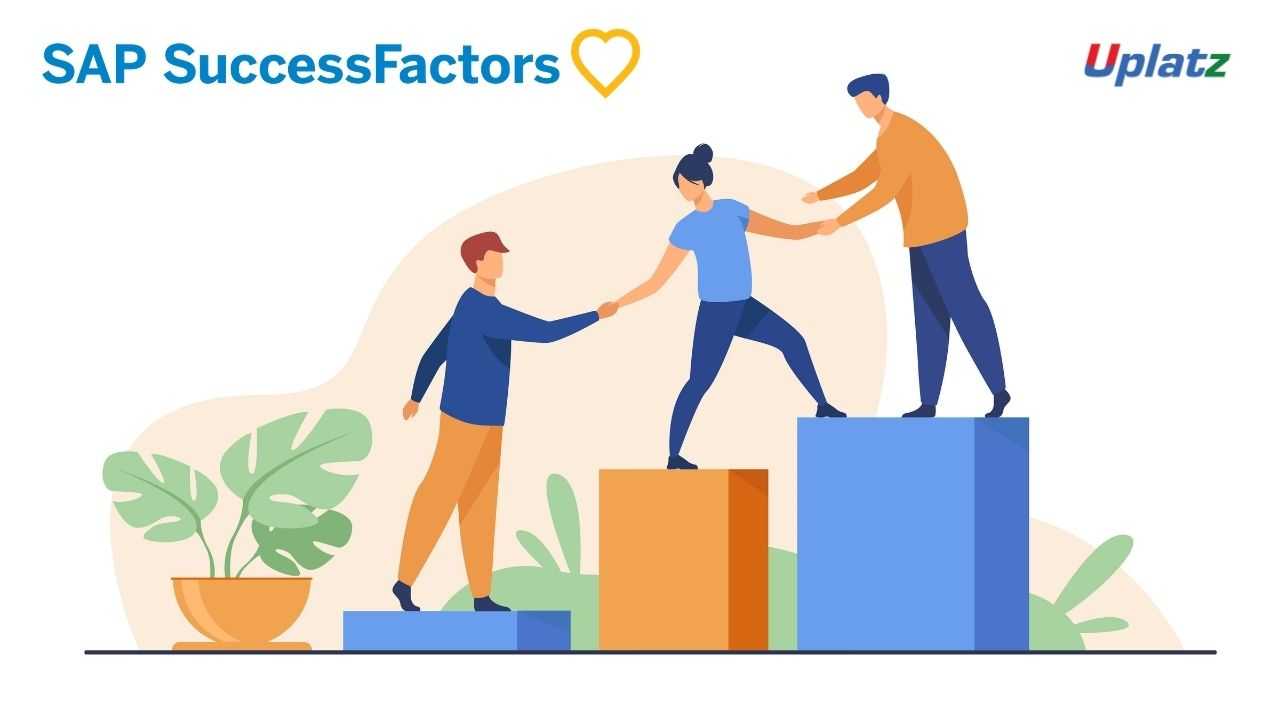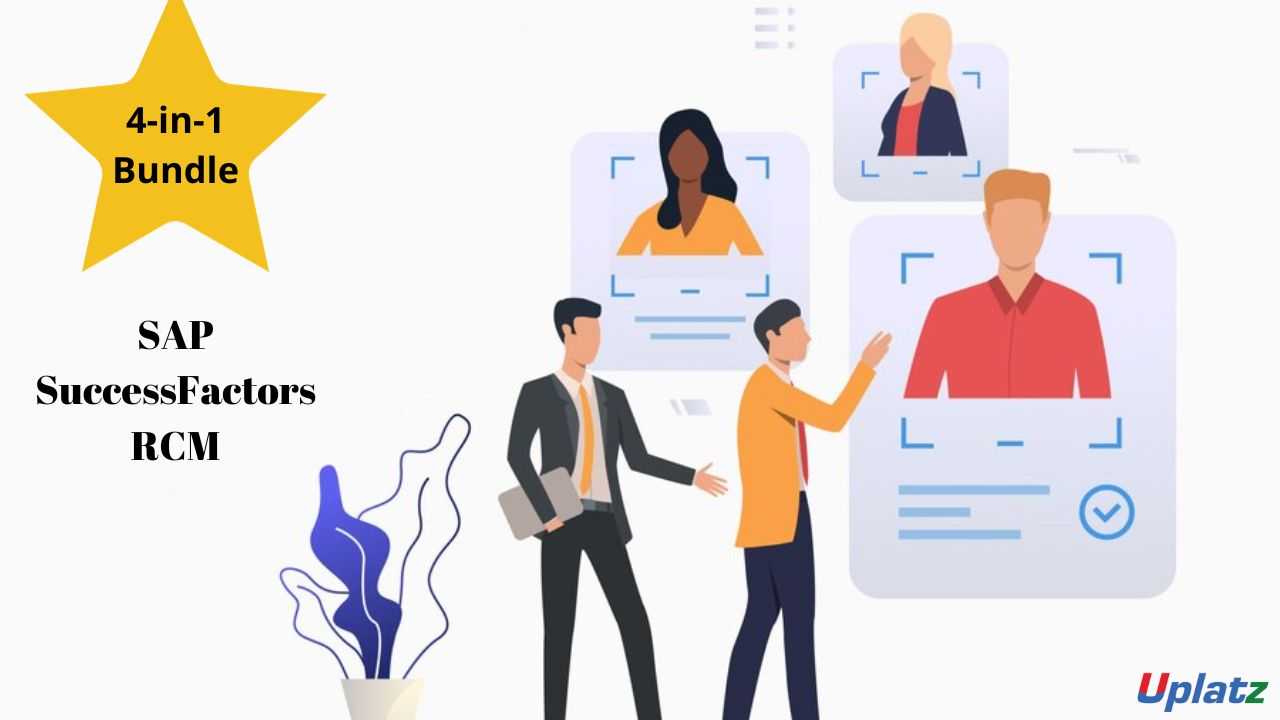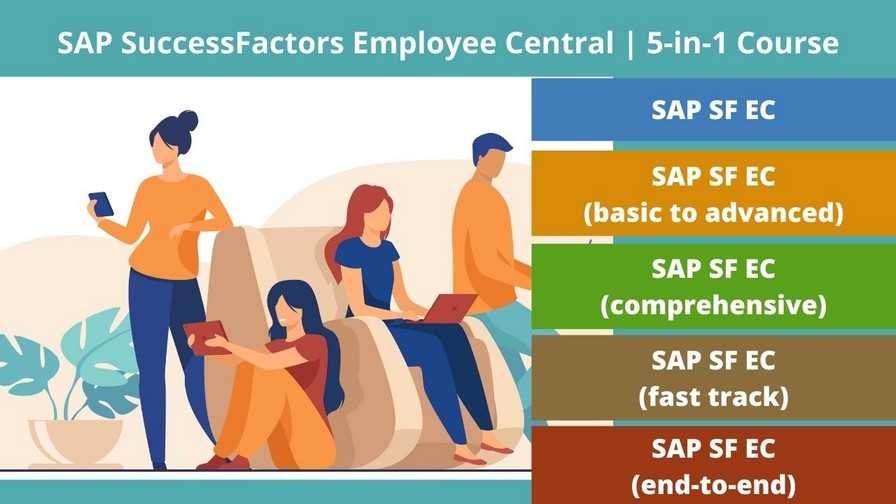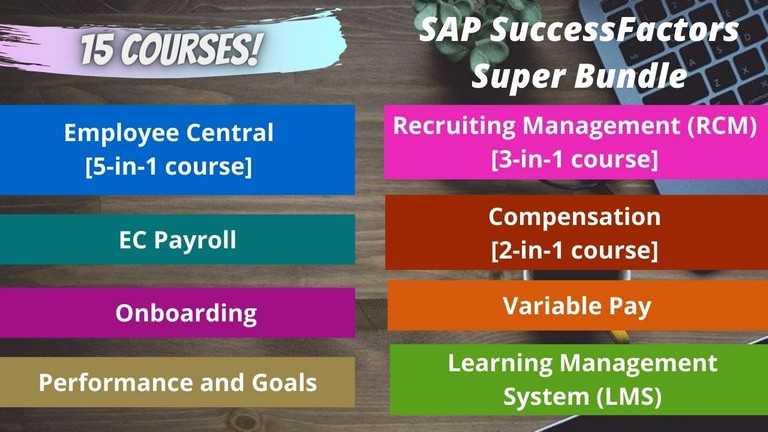SAP SuccessFactors Employee Central (comprehensive)
Become SAP SuccessFactors Consultant. Learn to configure Employee Central for HR data & processes, employee records, absence management, time sheets. View Course Curriculum
Price Match Guarantee
Full Lifetime Access
Access on any Device
Technical Support
Secure Checkout
Course Completion Certificate
View Course Curriculum
Price Match Guarantee
Full Lifetime Access
Access on any Device
Technical Support
Secure Checkout
Course Completion Certificate
 49% Started a new career
BUY THIS COURSE (GBP 29)
49% Started a new career
BUY THIS COURSE (GBP 29)
-
 69% Got a pay increase and promotion
69% Got a pay increase and promotion
Students also bought -
-

- Bundle Multi (4-in-1) - SAP SuccessFactors RCM
- 75 Hours
- GBP 49
- 562 Learners
-

- Bundle Multi (5-in-1) - SAP SuccessFactors Employee Central
- 100 Hours
- GBP 49
- 1930 Learners
-

- Bundle Super - SAP SuccessFactors
- 250 Hours
- GBP 49
- 846 Learners

SAP SuccessFactors Employee Central is a cloud-based module by SAP goes beyond basic automation to deliver a suite of applications for your most demanding business priorities. The next-generation Core HR system (HRIS) is designed for the global enterprise workforce and delivered securely via the SuccessFactors cloud, serving more than 27 million users.
SAP SuccessFactors Employee Central is a next generation HR system that utilises cloud-based global technology to manage core human resources and payroll. With SAP SuccessFactors Employee Central you get a revolutionary HR management system (HRMS) that enables you to unify all your employee data and manage your workforce in one place.
Some of the key features of SAP SuccessFactors Employee Central include:
1. Core HR management: The module provides a centralized platform for managing HR data, such as employee information, job profiles, organizational structures, and more.
2. Time and attendance: The module provides a comprehensive solution for time and attendance tracking, which includes scheduling, absence management, and time recording.
3. Payroll integration: The module can be integrated with payroll systems to manage payroll data and automate payroll processing.
4. Recruitment management: The module provides tools for managing the entire recruitment process, including job postings, candidate management, and interview scheduling.
5. Performance and goal management: The module enables managers to set performance goals, conduct performance evaluations, and provide feedback to employees.
6. Learning and development: The module provides tools for managing employee training and development programs.
SAP SuccessFactors Employee Central is used by organizations of all sizes across various industries. It provides a comprehensive HR solution that can be customized to meet an organization's specific HR needs. The cloud-based platform is scalable, which makes it suitable for growing organizations that require a flexible and easily accessible HR solution. Additionally, the platform is designed to enhance workforce engagement by providing employees with easy access to their HR data and enhancing their overall HR experience.
Uplatz offers this in-depth training on SAP SuccessFactors Employee Central module.
The course will begin with an overview of Employee Central, and will include topics on Core HR for employees, managers, and HR administrators. The videos will include how to affect organizational and position management, as well as how to set up rules and workflows. You’ll learn about Global Payroll and Benefits, and country-based benefits using Employee Central Payroll and the Payroll Control Center. You’ll also learn how to configure deductions and advances, as well as reporting and analytics. Finally, you will learn how to configure Employee Central for absence management and time sheets. The course will end with a recap of Core HR.
Key topics covered in this SAP SuccessFactors Employee Central training are: Systems used to configure SuccessFactors HCM, Resources available to consultants, Implementation and Integration Information, Management of data, user records, and security, Configuration of Rating Scales, Route Maps, and the Employee Profile, SuccessFactors Language Packs, Analytics, Explain Employee Central as an HRIS, including features and functions from both an end-user and implementation viewpoint and how it is used as a System of Record, Prepare a basic EC test environment, Foundation Table creation, configuration and management, HR Data configuration and management, Implement Role-Based Permissions (RBP), Implement Self-Service including Events/Event Reasons and Workflows, Describe and configure MDF, Rules Engine, Reporting, Time Off, and Integration (HRIS-Sync and API Users), Describe the role of the EC Consultant in Payroll and Benefits.
Course/Topic - SAP SF Employee Central (comprehensive) - all lectures
-
In this first lecture session of SAP SuccessFactors Employee Central (comprehensive) we talk about basic functions and techniques of SAP SF EC and also talk about success factors of employees.
-
In this lecture session of SAP we learn about how we use the business rules and also talk about the central comprehensive.
-
In this lecture session we talk about community SuccessFactors and also talk about area of queries and basic configurations.
-
In this lecture session we talk about notable fixed issues and also talk about different types of issues present in the success factor of employees.
-
In this lecture session we learn about release management, change management and incident management.
-
In this lecture session we learn about implementation of sequence and also talk about basic modules of implementation.
-
In this lecture session we learn about manager organization, payroll, and job structures.
-
In this lecture session we learn about the basic tool best run and also learn how we handle queries in the best run.
-
In this lecture session we learn about how we create foundation objects and how we handle these foundation objects.
-
In this lecture session we learn about frequency form and also learn how to create the frequency form in SAP.
-
In this lecture session we learn about system landscapes and how we configure the system landscapes.
-
In this lecture session we talk about set user permission and also talk about different types of user permission in SAP.
-
In this lecture session we learn about positions in SAP and also learn how we create a position in SAP.
-
In this lecture session we learn about the overview of the profile of the employee we created and also talk about the basic function of the profile.
-
In this lecture session we talk about compensation information and basic importance of compensation information.
-
In this lecture session we talk about how we enter the data in bulk and also learn how we approve the bulk data in SAP.
-
In this lecture session we overview the admin centre and also talk about how we import the foundation data in SAP.
-
In this lecture session we talk about basic examples of how we import the data in foundation in SAP.
-
In this lecture session we talk about bulk import, how we import the employee in bulk and also talk about best techniques of importing.
-
In this lecture session we talk about importing foundation data and also cover the best techniques of importing foundation data in SAP.
-
In this lecture session we talk about the difference between the importing foundation data and import and export data.
-
Lecture 15.2 - SAP SuccessFactors Employee Central (comprehensive)
-
In this lecture session we learn about how we create a group and how we add employees in bulk in the excel sheet.
-
In this lecture session we learn about how we edit the history of personal information in the best way.
-
In this lecture session we talk about a condition in which we enter the first name and last name of the employees.
-
If the personal first name is not equal null and then personal information display name to be equal to personal information first name.
-
In this lecture session we talk about how to create a rule and also cover how we expand the rules.
-
In this lecture session we learn about design sheets and also talk about how we configure the selected groups.
-
In this lecture session we talk about how we add new rating sources and performance management forms.
-
In this lecture session we talk about compensation information and also talk about compensation basic techniques.
-
In this lecture session we talk about live profile MDF information and also talk about experience details.
-
In this lecture session we learn about managing organisation pay and job structures.
-
In this last lecture session we talk about badge of SAP SuccessFactors Employee Central (comprehensive).
• SAP Success Factors is Among Advanced SAP Modules catering to advanced HR requirements.
• Growth of Every Organization is directly linked to Organizational Policies & Performace of their Employees.
• This course will equip participant with the knowledge of SAP SuccessFactors HCM Cloud Suite platform, perform configurations to common elements, and populate user data.
• This is where Success Factors Stands out & is leader in industry in managinig employees performance, goals etc.
• Participant will gain the skills necessary to perform the core configuration for a SAP SuccessFactors Employee Central system and become familiar with the resources and support available to configure additional features.
• Since it is Latest, its pay package is amongst Highest in Industry.
• Learn end-to-end practical implementation & configuration of SAP SuccessFactors Employee Central.
SAP SUCCESSFACTORS (Employee Central) - Comprehensive
Module: Introduction to Mastery Topics:
1. Cloud and SF Architecture
2. Instance, Provisioning explanation
3. Technical Architecture
4. Integration Technology/Tools
5. Bizxpert Methodology – Implementation Methodology.
6. Basic company settings in Provisioning
7. Creating administrators in Provisioning
8. Creating administrators in Instance
9. Instance basic settings – Passwords, Home Page, Welcome Menu, Company info, Employee files
10. Administrator tools
11. Commonly used terms
12. Admin Privileges
13. Proxy Management
14. Setting up company Logos
15. Manage Data User Records
16. Employee Data File
17. Permissions
18. Role Based Per missioning (RBP).
19. Pick list Management.
20. Text Customization in Instance
21. XML and Data models
22. People Search
23. Rating Scales
24. Route Maps (Workflow)
25. Launching forms
26. Employee Profile
Module: Employee Central Mastery – Core HCM module
1. Introduction and basic provisioning set up exercises
2. Data models
3. Employee Central Structure
4. Data model Management
5. Data model Associations
6. Enable employee central and RBP
7. Update employee details
8. ESS/MSS functionality
9. Understanding security
10. Managing security with RBP
11. EC as a system of record
12. EC Customizing and Populating Basic Foundation data
13. Customizing Country specific files in Foundation tables
14. Creating and modifying associations
15. Propagations
16. Importing users and data
17. Mass Changes
18. Customizing employee files
19. Customizing CSF for employee files
20. Position Management
21. Absence Management
22. Employee Central Reporting and Integration
24. MDF Overview
25. MDF Objects creation
26. Manage Business Configuration Rules setup
27. Manage Workflow Requests/groups
28. Org Chart
29. Manage Sequence
30. Monitor Job
The SAP SuccessFactorsEmployeeCentral(comprehensive) Certification ensures you know planning, production and measurement techniques needed to stand out from the competition.
SAP SuccessFactors Employee Central is a flexible, global core HR solution that supports core HR processes and employee self-services for your total workforce. Increase productivity with an HRIS system that automates processes and provides employee self-service HR tools.
SuccessFactors Employee Central Payroll is a cloud-based payroll system meant to provide the breadth of functionality and global coverage enterprises need. The core Employee Central Payroll system is built using the SAP Payroll engine, providing a reliable and proven engine for calculating the most complex of payrolls.
SAP SuccessFactors (sometimes referred to casually by users as “SF” or “SFSF,” although neither are officially recognized by SAP) is an HR tool that provides cloud-based software for human capital management (HCM), using the software-as-a-service (SaaS) model.
Uplatz online training guarantees the participants to successfully go through the SAP SuccessFactorsEmployeeCentral(comprehensive) Certification provided by Uplatz. Uplatz provides appropriate teaching and expertise training to equip the participants for implementing the learnt concepts in an organization.
Course Completion Certificate will be awarded by Uplatz upon successful completion of the SAP SuccessFactorsEmployeeCentral(comprehensive) online course.
The SAP SuccessFactorsEmployeeCentral(comprehensive) draws an average salary of $105,000 per year depending on their knowledge and hands-on experience.
Our flexible, cloud-based human resources information system (HRIS) software automates HR workflows and intelligent services on a single global platform, so you can support processes and employee self-services for your total workforce.
SuccessFactors Employee Central provides an option to manage key HR operations and contains HR master data like employee name, identification, user name, etc. As SuccessFactors is a cloud solution and manages quarterly, you can easily accommodate an organization's changing workforce structure.
Note that salaries are generally higher at large companies rather than small ones. Your salary will also differ based on the market you work in.
Product Expert-SAP TM.
Developer Associate.
Senior Account Executive.
Q.1. How do you integrate Employee Central with other SuccessFactors Products?
Employee Central integrates internal with other SuccessFactors products through HRIS Sync.
Q.2. How do you integrate Employee Central externally with other products?
There is a cloud -based integration platform available for external integration.
Q.3. What does the Succession Data Model contain?
The Employee Records are contained in the Succession Data Model. The succession data mode configures the fields that will appear in the Employee’s Personal Information (outside of work) Employment Information (inside of work).
Q.4. What is configured in the Country -Specific Succession Data Model?
Address formats, country specific fields and international standards are set in the country-spe, succession data model.
Q.5. What does the Corporate Data Model define?
Foundation Objects and their relationships are defined in the corporate data Model. Foundati, Objects are also called Foundation Tables. They include Organization, Job and Pay.
Q.6. What is defined in the Country -Specific Corporate Data Model?
In here foundation objects fields for a separate country are defined.
Q.7. What is the propagation data model used for?
HRIS Propagation Data Model is used for the Auto Population from Foundation Tables
Q.8. What other two data models are used?
Data Model Workflow Rules Data Model, Event and Event Derivation Rules Data Model
Q.9. How many data models are there in Employee Central?
7
Q.10. How do you masked sensible data in a field?
Set the attribute pii=”true”
Q.11. How do you set a field so the user can edit it?
Set the attribute visible=”both”
Q.12. How do you make a field to be required to be filled?
Set the attribute required=”true”
Q.13. What is a DTD?
Document Type Definition of the data model
My vision is to build a truly integrated HR in the cloud. A truly integrated HR is the key enabler for Organizations to maximize their business outcomes.
Q.14. Why are they called ‘SuccessFactors’?
Because they are behaviors which lead to successful performance in the job.
Q.15. Why are there three levels within the framework?
They describe a range of different types of behavior which are relevant to a range of different job roles. However, the levels are not hierarchical.
Q.16. Are the levels linked to job grades?
No. Just because someone is on a certain job grade, it doesn’t rule out any of the levels. However, if a job is more senior you would expect to see more of the university level behaviours.
Q.17. Are they going to apply to academic staff as well?
There is a similar framework for Strategic Leaders Framework and one for researchers which have been based on Success Factors. The idea going forward is to have something similar for all staff groups in the university.
Q.18. Will Success Factors be used to ‘get rid’ of people?
That is not why they have been developed. They are used to develop individuals. However, if the behaviour(s) are essential to the job and there continues to be no development then it could become a performance issue.
Q.19. What if the employee doesn’t agree with the Success Factors that their manager has chosen?
The manager uses the job analysis information to determine the Success Factor for the role in conjunction with discussions with the individual. However, it is ultimately the manager’s decision.
Q.20. Once a Success Factor has been chosen for a role can it be changed?
Yes; it depends on the requirements / needs of the role at any point. It is fluid and therefore may change year on year.
Q.21. If a Success Factor is changed during the year how do you know what you will be reviewed against at the next PDR?
Through dialogue / communication between the manager and the individual. The change can also be flagged on the PDR form.
Q.22. Do you have to choose the same level (e.g. self) for all the Success Factors identified?
No. However, it may be that they tend towards one level.
Q.23. If SuccessFactors are important – how do you pick the right ones?
Use the job analysis information and advice from your HRO and other managers with the same roles to determine the 3-5 core success factors. It will become easier with practice.
Q.24. What if the Success Factor for a role is what the job requires as a technical output e.g. communicating for a careers’ adviser?
There may be a ‘technical’ requirement to do that but successFactors are about ‘how’ the job is done / the behaviours required in carrying out their job.
Q.25. If an individual achieves all the Success Factors does that mean they will get promoted / get more pay?
Not directly. Obviously the more successful the individual is in their role / can demonstrate effective job performance / demonstrates additional behaviours, then this can be used as evidence in any job application or pay review case.
Q.26. What support will I have in using the SuccessFactors?
Managers will receive training; Success Factor documentation and guidance on its use will be available on the HR web site; members of the HR team will be able to provide advice.
Q.27. Won’t the choosing of the SuccessFactors be too subjective?
There is always an element of subjectivity in any process dealing with people. However, Success Factors are objective standards or benchmarks with good examples.
Q.28. How much evidence in assessing Success Factors will we be expected to produce?
Look over the previous 12 months for examples and pick out the 2 or 3 which demonstrate the Success Factors the most.
Q.29. Won’t the assessment of SuccessFactors take too long?
Initially, making the assessment may take some time because it is a new process and we’re dealing with new concepts but it is worthwhile for the benefits they bring.









